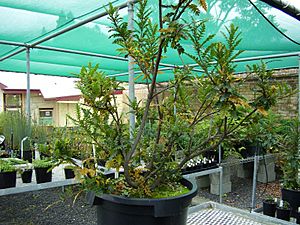King's lomatia facts for kids
Quick facts for kids King's lomatia |
|
|---|---|
 |
|
| Lomatia tasmanica in Hobart Botanical Garden | |
| Conservation status | |
| Scientific classification | |
| Genus: |
Lomatia
|
| Species: |
tasmanica
|
Lomatia tasmanica, also known as King's lomatia, is a special shrub found only in Tasmania. It belongs to the plant family called Proteaceae. This plant can grow up to 8 meters (about 26 feet) tall.
King's lomatia has shiny green leaves that are divided into many smaller parts. In the summer, it grows red flowers. But here's a cool fact: it never produces any fruit or seeds! This is because all King's lomatia plants are exactly the same, like clones. They are also triploid, meaning they have three sets of chromosomes, which makes them unable to have babies in the usual way.
Instead, new plants grow when a branch falls off and grows new roots. This new plant is a perfect copy of its parent.
A man named Charles Denison "Deny" King found this plant in 1934. But it wasn't officially named until 1967 by a botanist named Winifred Mary Curtis. Today, there's only one group of King's lomatia plants left in the wild. It has about 600 plants spread over 1.2 kilometers (about 0.75 miles).
Contents
What King's Lomatia Looks Like
King's lomatia plants are usually tall, thin shrubs or small trees. They can reach up to 8 meters (26 feet) high. Older plants might have trunks up to 8 centimeters (3 inches) wide.
The younger branches are covered in fine, reddish-brown fuzz. If a stem touches the ground, it can grow new roots. The leaves grow one after another along the branches. They are grouped closer together near the ends of the branches.
The leaves are shaped like an oval and are about 10–18 centimeters (4–7 inches) long. They are pinnate, which means they have 11 to 25 main parts, like a feather. These parts have jagged edges and sometimes have even smaller parts. The top of the leaf is green and shiny. The underside is a bit hairy, especially along the middle vein.
King's lomatia flowers in February. Its flower clusters grow at the ends of the branches and are about 9–10 centimeters (3.5–4 inches) long.
How King's Lomatia Was Discovered
Charles Denison "Deny" King first found this plant in May 1934. He was mining for tin in a faraway part of southwestern Tasmania. Later, in 1965, he sent some plant samples to be identified.
Winifred Curtis from the Tasmanian Herbarium officially named the plant in 1967. She named it in King's honor. Sometimes, people call it "King's holly," but it's not actually a holly plant.
Scientists have studied the genes of King's lomatia. They found that it is closely related to two other Lomatia species found in Tasmania.
Even more amazing, scientists found very old plant pieces that look exactly like King's lomatia. These pieces were found in rocks that are 43,600 years old! This means King's lomatia has been cloning itself for a very, very long time. It might even be one of the oldest living plant clones in the world.
Where King's Lomatia Lives
The only group of Lomatia tasmanica plants in the wild is in southwestern Tasmania. There are about 300 plants in an area less than 1.2 kilometers (0.75 miles) long.
This area gets a lot of rain, about 1700 millimeters (67 inches) each year. All the plants grow within 25 meters (82 feet) of a river or creek. King's lomatia mostly grows in rainforests or mixed forests. These forests have trees like myrtle beech, celery-top pine, and leatherwood. There are also smaller plants growing underneath the trees. The area is very wet, with lots of moss and ferns.
King's lomatia can also be found in other types of forests nearby. It can grow in areas with different kinds of trees and plants, like blue-green tea tree and button grass.
Conservation and Protection
King's lomatia is in big trouble. The Australian government has said it is "critically endangered." This means it is very close to disappearing forever. The Tasmanian government also lists it as "Endangered."
The first group of plants that Deny King found in 1934 has now died out. The only remaining group of about 500 plants is in a small area of southwestern Tasmania. This area is at risk from bushfires and other natural dangers.
Because of this, the Royal Tasmanian Botanical Gardens has started growing King's lomatia. They are trying to create new groups of the plant in safe places. They have been growing plants from cuttings since 1994. These special plants are not shown to the public because they are so rare and delicate.
Since King's lomatia cannot make seeds, it's impossible to create new plants with different genes naturally. This means all the plants are exactly the same, which makes them more vulnerable to diseases.
One danger is a fungus called Phytophthora cinnamomi. This fungus has been found near some wild King's lomatia plants. A bushfire could spread this fungus and infect the remaining plants.
Scientists at the Botanic Gardens are also trying to graft King's lomatia onto other related plants. This might help them grow better and be stronger.
Cultivation
It's quite easy to grow new King's lomatia plants from cuttings. Cuttings are usually taken in January and February. It can take up to a year for them to grow roots.
However, it's hard to keep these cultivated plants alive. They often die if they dry out. Like the wild plants, the cultivated ones can also get sick from the Phytophthora cinnamomi fungus.
To help them survive, King's lomatia has been successfully grafted onto another plant called Lomatia tinctoria. The Botanic Gardens also wanted to try grafting it onto L. ferruginea.
See also
 In Spanish: Lomatia tasmanica para niños
In Spanish: Lomatia tasmanica para niños


